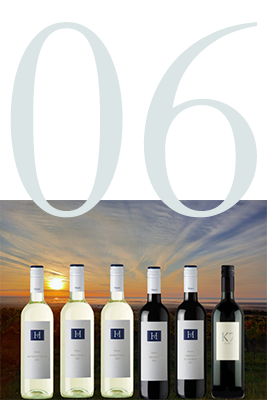
Those who have participated in Höpler tastings and teach-ins may recall our dislike of the simplicity of ‘labels’ used to categorise products, styles, people and processes in today’s world. It reduces often highly complex issues into ‘camps’ which are viewed as ‘good’ or ‘bad’. This may work, in the very short term, for marketing departments and ‘snapshot learning’ but we are unconvinced it helps consumers make informed decisions for the long-term benefit of our planet.
At Höpler we question everything. We look at the evidence, try new things, assess the differences and continue to tweak our processes. Where we are convinced we move quickly – we switched to lightweight bottles 15 years ago, invested in solar energy in 2017, cover crops between rows for decades, no herbicides, no irrigation, new efficient equipment, years of fallow vineyards before replanting, surface tilling only directly between the vines for weed management, the list goes on.
Where the facts are more difficult to ascertain we tread more carefully. This is especially the case when it comes to vineyard management, there are so many variables (especially due to weather, aspect and soils) that direct cause and effect are difficult to establish.
The truth is we adjust the management of our vineyards according to each site in combination with the weather, the year and age of the vines. Just like children, each one is different. On the lower slopes of Kirchberg the challenge is too much growth, on the steeper edges cooler winds can delay growth. We put organic matter on the later and nothing on the former. In 2022 for example we deliberately reduced yields to ensure less strain on the plants and aid higher grape quality in such a dry year. This hurts our revenues but we need these plants to last decades.
The challenge nearly all wine producers face worldwide regardless of ‘label’ (conventional, sustainable, regenerative, organic or biodynomic) is how to mitigate against downy and powdery mildew using less chemicals. One solution we are considering is PIWI varietals. PIWI vines are fungus-resistant hybrid grapes crossed with the Vitis species. These new varietals look promising but adopting these ‘new varietals’ will require significant re education of the consumer, helping them understand a whole new set of grape varietals. It will take decades and if winemakers are brave enough to plant them it is likely the grapes will initially be used for blending wines while knowledge and experience about their qualties is gained.
Höpler is a certified sustainable grower a label that encompasses a wide spectrum of viticultural practices. Keen to learn more we have been participating in the SECBIVIT biodiversity project over the last three years. This international study compares the effects of inter-row management and pest control between conventional and organic viticulture across five countries Romania, Austria, Germany, France and Spain. The scientists have published part of their findings already and will reach their final conclusions in the spring of 2023.
The updated data from 2022 demonstrates, that there is double the presence of beneficial mites in the Austrian vineyards farmed conventionally than their organic peers (high numbers indicate health of habitat). The data also shows that the earthworm count (an indication of soil vitality) was also significantly higher in the conventional vineyards. There was slightly more plant variation in the rows farmed organically but these numbers were highest when cover crops between rows of vines grew spontaneously rather than re sewn every year (regardless of management type). The data did not find any clear difference in bird life according to management practices but did find more variation and numbers of birds when there was a more diverse range of surrounding natural habitats. Our region in Austria showed a higher diversity in birds when compared to other countries.




The data has been consistent over the project and we are delighted that data is being gathered in a scientific way in this complex area. We expect the results are down to 2 key differences in management practices.
*For more information on the project please visit the SECBIVIT website here. The results page will direct you to the scientific journals these are published in. The articles are not very consumer friendly!!
Höpler GmbH, Heideweg 1
7091 Breitenbrunn, Austria
+43 (0)2683 23907
office@hoepler.at
Höplers Weinräume, Hauptstraße 52,
7092 Winden am See, Austria
+43 (0)2683 23907-30
info@weinraeume.at
ÖFFNUNGSZEITEN BÜRO | |
|---|---|
Mon to Thurs | 7:30am – 4:30pm |
Friday | 7:30am – 12pm |
Sat/Sun | Closed |
Website: proportionmarketing.co.uk
Frohes neues Jahr 2024
Betriebsurlaub
Wir sind ab dem 8. Januar wieder für Euch da!


Lorem ipsum dolor sit amet, consectetur adipiscing elit. Ut elit tellus, luctus nec ullamcorper mattis, pulvinar dapibus leo.